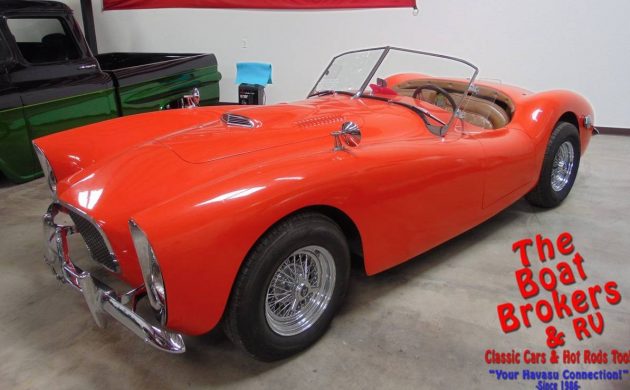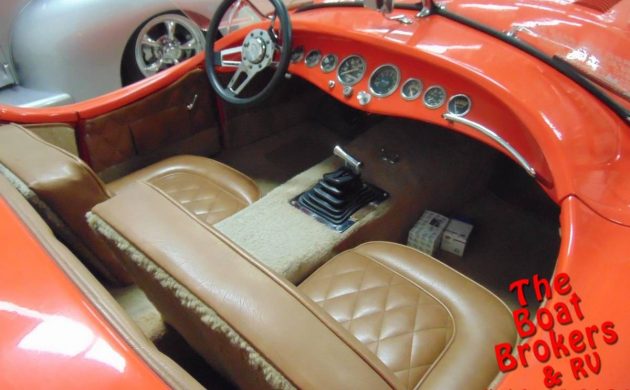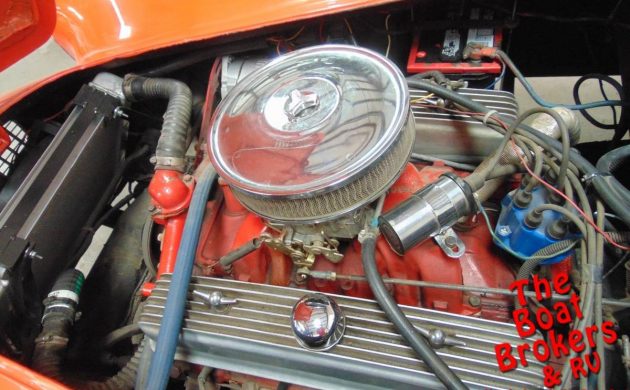Opinions tend to vary on the claim that the Glasspar G2 was the first all fiberglass-bodied production sports car built in America. Those that dispute the claim point to the low production numbers as not justifying the claim, while others claim that if the manufacturer sold any complete cars, then this justifies the car’s status as a production car. Whichever camp you might fall into, the fact is that they are a fairly rare car, and they simply don’t come onto the market very often. Barn Finder Roger spotted this example for us, so thank you so much for that Roger. It is located in Havasu City, Arizona, and is listed for sale here on Craigslist. The owner has set a sales price of $62,500 for this little beauty.
The sticking point with this car is whether it could be considered a fully original Glasspar, or whether it would be classified as a kit car. It is certainly true that a prospective owner could walk into the company and drive away in a completed car, as they not only manufactured the fiberglass body but their own tubular chassis as well. All of the running gear was sourced from other manufacturers, mainly from Ford. However, the company could also sell you a bare body, or a body and chassis, and then it would be up to you to complete the car to your own specifications. Sales records are now non-existent, but it is believed that total body production only amounted to about 150 shells, while no-one really knows how many chassis or complete cars were eventually made and sold. I have seen one source that places the figure at 10 cars and even states that such celebrities as Gary Cooper and Rosemary Clooney were numbered amongst G2 owners. That also means that this is a car that might just require a bit of detective work to confirm its history. Looking at the G2, it does seem to present quite well. The panel fit and finish is better than average for a kit car body, while the red paint has a nice shine to it. I would be very interested to know exactly what sort of chassis is lying underneath this car because that would be the first step in confirming its authenticity. The styling of the car is extremely attractive, and there are definite hints of cars such as the Austin-Healey in the overall design. One notable detail is the hood scoop. I’ve looked at photos of a number of G2 examples in researching this story. Some have the hood scoop, while others don’t. The ones that do all seem different to this one, and this looks like it would be at home on a Thunderbird, so I suspect that it isn’t original.
Defining what would be considered to be an original Glasspar interior is just as difficult as virtually everything else with the car. The upholstery on the seats along with the carpet both look to be about the right style and color, as do the gauges and the dash-mounted rearview mirror. The upholstery on the door trims isn’t a match, and I’m wondering whether they might actually be the original items. What definitely isn’t right is the wheel and the shifter. They look totally out of character, and I would probably want to do further research if I bought the car, just to make sure that these items were right.
Under the hood of this G2 is a 322ci Buick Nailhead V8, which is backed by a Hydramatic transmission. This is another area that throws a few questions up with this G2. It is entirely possible that the transmission is original, but the engine almost certainly isn’t given the fact that the 322 Nailhead was introduced in the 1953 model year. It’s pretty doubtful that you would see one gracing the engine bay of a 1952 Glasspar. The owner doesn’t provide any information about how the car runs and drives, but its diminutive size and weight suggests that it would be a very entertaining little car on the road. The owner also claims that the car has only covered 35,000 miles, but doesn’t indicate whether they hold documentary evidence to confirm this.
When reflecting upon the authenticity of this Glasspar, there is one factor to take into consideration. By my way of thinking, if this was nothing but a Glasspar kit, I would expect the asking price to be significantly lower than it is. The fact that the owner has set the price where it is indicates that they may have a fair amount of confidence about its authenticity. That would seem like a pretty obvious place to start any negotiations on this car. Just ask the question.








Not being well-versed in the early history of fiberglass body kits, I can only make a few guesses, Adam. This may be the “real deal,” but “original” it is not! Headlights, grille, shifter, wheels (both road and steering) are more modern products. So, as you say, is the engine. The front end has been reshaped somewhat to accommodate the lights and grille.
So what do we have? I’d say this started as a homebuilt kit that wasn’t finished until years later. The work might have been very recent, judging from the lack of, well, patina.
I would suspect a really good sleuth could find a few never-built Glasspar or Woodill bodies hung from garage rafters, or maybe even sitting on a ’40 Ford chassis, which was one of the preferred bases for “special” builders back in the day. In the early ’60s, a friend’s dad had a Henry J fame and engine waiting for just such a conversion. Like many (most?) projects of that type, it never happened.
I was surprised to learn of the G2 about 10 years ago. For over 30 years I have owned a 1963 Glaspar G3. It is one of the early fiberglass boats. But in all that time, I hadn’t known a G2 car even existed.
I have always thought the G3 is a striking design. Not over the top like may finned boats of the era, but subtly unique.
Disclosure: My G3 is just a hull that needs total restoration. Yep, another 30 year project not started.
Just a question. I thought the darrin was the first u.s. fiberglass built car.
I wonder if these were built by the Glasspar boat company?
Yes. And “Woody” Woodill based his “Wildfire” on the Glasspar bodies, too.
You must call “Corvette Debbie” now I’ve heard it all. So for $62,500.00 other than the transmission being in Park, a yellow painted piece of wood suffices for the parking brake?
Your writer seems to question whether the steering wheel and shifter are “original” items – I respectfully submit that you should look up the word ‘anachronism’ in the dictionary. I don’t mean to be hypercritical but the upholstery looks to be by the local “BillyBob’s Dinette Re-Cover Company.”
One would also want to know how is this titled, what does it have for a V.I.N.? Is there a chassis plate with a number by Glasspar and is that on the title? That would be a start. Has Geoff Hacker weighed in on this yet? He may know as much as anyone.
People get wildly emotional (polite way of saying crazy angry) when discussing “kit cars” pro or con but sometimes there are hazy areas. For instance I own an old replica Cobra titled and registered as a 1977 Pilgrim. It has a Pilgrim chassis plate with a V.I.N. and that is what it has always been registered as.
I’ve talked to people in U.K. that tell me Pilgrim didn’t exist in 1977 and only began building kits in 1984 so clearly my car is a kit and built sometime after 1984. But I have old records including M.O.T. certificates going back to 1978 identifying it as a 1977 Pilgrim. So does anyone have any idea what the truth is about any old custom built car that may or may not have been built by a “manufacturer” rather than being homemade in a driveway or back yard??
The grill appears to be a 1956 to 61 Studebaker Hawk, with the center section painted black, and the whole grill slanted forward instead of backward as it was on the Hawk. Of course that grill assembly wasn’t available in 1953 or 54.
Also, while that engine is an early 322 nailhead, the carb is much newer.
Cool ass ride!!! I bet it flies!!!
I don’t think my size 12 feet and 200lb body would fit in this toy car.
Bob
This is one of the nicer ones for sale recently.
.
The Nailhead was a popular choice… although the body was introduced in ’52, most of them were finished “years” later . By Motoring Standards, the G2 was never a Production Car and any claim as the first Production Sports Car is irrelevant to it’s significance. Jaguar influence maybe, but the Healey was not.
Lots more than 10 survived…I have had 6 through the shop,
.
including this one with a Dodge 318 …(original engine was a flathead Ford V8) ..
It was in the same family for 50 years before I bought it …and it ‘appears’ with original Glaspar grill and Glaspar windshield….
That’s sick AF.
I’d be afraid, very afraid, to drive this car with all that unsupported glass in front of me for a windshield. Seems twice as tall as one from a Cobra. At least there is a center divider for “support.” Nice G2, Dave.